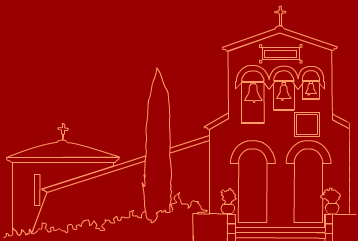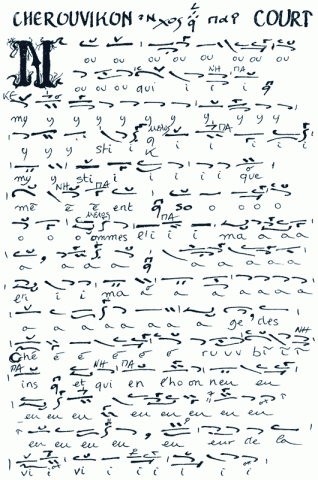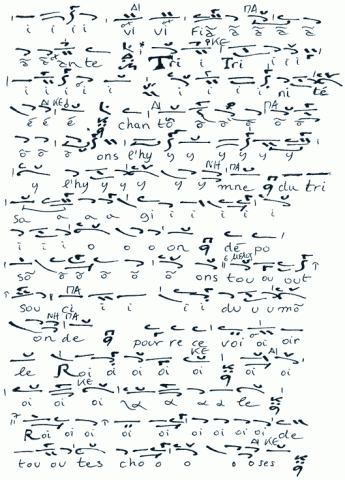Psaltic Chant

Byzantine music is a complete musical system employing the rich palette of Eastern Mediterranean scales in order to highlight biblical and hymnological texts that beautifully express the theology of the Fathers of the Church.
Psaltic musical notation
The notation of Byzantine music, or psaltic, derives from the Greek system of accentuation (oxeia, apostrophos…) that evolved over the centuries into neumas (descriptive signs). Written above the text line, neumas accentuate the music syllables, i.e. give them the appropriate intonation and expression. Neumas, contrary to Western melodic notation, point to simple height variations. These “Byzantine notes” therefore have a relative value, they only have meaning in relation to each other. They are grouped into melodic movements that vary according to different modes (four main and four plagal modes), and different types of chant.
Here is an example of the chant notation for the Cherouvikon .
Interpretation
A Byzantine score must always be interpreted beyond the strict notation: in the oriental tradition, this “notation” is a simple skeleton that needs to be completed with multiple vibrations and energies only taught from master to pupil. In this respect, Byzantine music is very much indebted to Simon Karas and his successor Lycourgos Angelopoulos. Indeed, as a result of a weakness in personal oral training, cantors had come to suppress little by little the interpretation of neumas: the characteristics of Byzantine music were eroded and replaced by harmonisations, variations in intensity, sentimental expressions, and so forth. Simon Karas has invested himself in an huge task of musicology in order to rebuild the theoretical underpinnings of Byzantine music, and in order to restore the Byzantine melodic line with its dynamic force, he reinserted many signs from ancient notation.

The ison (continuous bass note)
The ison is the sole accompaniment of Byzantine music. Its placement is a matter of musical theory, since the ison reveals and underscores the base of the mode in which the melody evolves. The ison thus confers the melody its modal colour. The ison is therefore irreplaceable. Other monophonic musical traditions also use the ison (Celtic music for example)
Different types of Byzantine music
1. Sticharion type: Sticharia are hymns interspersed within psalms, illustrated here, by the Paschal Doxastikon, one of the high points of the liturgical year.
2. Papadic type: This type is for hymns from the Divine Liturgy (Holy Mass). The example is the Cherubikon in the first tone, sung at the procession of the Holy Gifts (the Offertory).
3. The Polyeleos takes its name form Psalm 135: “For eternal is your Mercy” (eleos in Greek), sung at Matins of Great Feasts.
Byzantine music in French
HOLY NIGHT OF EASTER
Choir of the Brotherhood of Christ the Saviour of Fribourg (Switzerland).
Conductor: Father Symeon.
1 – Procession, tone 1 pl. & 2 pl. 2:57
2 • Odes 1 & 3, tone 1 3:39
3 • Hypakoï, tone 4, odes 4 à 6, tone 1 6:56
4 • Kondakion & synaxaire, tone 4 pl. Song of the Resurrection, t. Varys 4:23
5 • Odes 7 & 8, tone 1 5:46
6 – Ode 9 and Megalynary, tone 1 7:46
7 – Exapostilary, tone 2 1:01
8 – Pasapnoarion, Sunday sticharia, Easter sticharia, tone 1 pl. 13:27
9 – Resurrection day, tone 1 pl. Christos anesti lent, tone 1 pl. 8:07
10 – Easter recreation, tone 1 pl. 3:06
11 – Kinonikon, tone 3 9:47
67:00
– – – – – – – –
HYMNES to St. JOHN THE BAPTIST
Choir of the Theotokos Monastery and St Martin.
Direction: father Symeon.
1 – Lauds: Sticharia, tone 4 pl. 4:31
2 – Lauds: Glory…, tone 2 pl. 3:27
3 – Lauds: Now…, tone 2 pl. 0:29
4 – Great Doxology, tone 3 5:30
5 – Tropary, Tone 4 0:38
6 – Kondakion, tone 3 1:31
7 – Cheruvikon, tone 1 7:01
8 – Anaphora, tone 3 4:28
9 – Kinonikon, tone Varys (low) 5:46
10 – We have seen, tone 2 1:02
11 – Litia: Sticharia, tone 1 pl. 1:30
12 – Litia: Glory…, tone 1 pl. 6:50
13 – Litia: Now…, tone 1 pl. 0:37
14 • Polyeleos, tone 1 pl. 6:10
15 • Cathism, tone 4 nenanô 3:42
54:00



